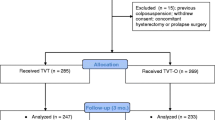Abstract
Introduction and hypothesis
This is a prospective randomized controlled trial of cough versus no cough test in the tension-free vaginal tape (TVT) procedure to determine its effect upon voiding dysfunction and 12-month efficacy.
Methods
The trial was conducted in a single tertiary urogynecology unit. Women ≥21 years old with primary urodynamic stress incontinence without voiding dysfunction were considered eligible. Participants were randomized to undergo the TVT procedure using either an intraoperative cough test or using no intraoperative cough test. Our hypothesis was that postoperative voiding dysfunction would be more common in the “no cough test” arm. The primary outcome was proportion of patients successfully completing a trial of void (TOV) within 24 h of catheter removal. Efficacy at 12 months comprised the secondary outcome. Participants were randomized using a computer-generated randomization sequence by an independent party who was not the operating surgeon. Due to the nature of the intervention to be tested, neither the patients nor the operating surgeons were blinded to the randomization process during the procedure.
Results
This trial is reported according to the recommendations of the 2010 CONSORT statement. In total, 94 women were recruited over a 4-year study period. Of these, 92 women were randomized (47 in the “cough” group and 45 in the “no cough” group). In one case, the TVT procedure was abandoned intraoperatively, leaving 91 women who underwent analysis. There was no significant difference in the proportion of women with a successful TOV within 24 h between the two arms (79% in the “cough” group versus 71% in the “no cough” group; p = 0.47). Efficacy data at 12 months were not significantly different between groups.
Conclusion
Our data suggest that the performance of the intraoperative cough test during the TVT procedure does not reduce the incidence of postoperative voiding dysfunction (as determined by successful TOV within 24 h) nor affect efficacy. The removal of the cough test from the standard TVT technique may be appropriate.


Similar content being viewed by others
References
Ulmsten U, Johnson P, Rezapour M (1999) A three-year follow-up of tension free vaginal tape for surgical treatment of female stress urinary incontinence. Br J Obstet Gynaecol 106:345–350
Murphy M, Heit MH, Fouts L, Graham CA, Blackwell L, Culligan PJ (2003) Effect of anesthesia on voiding function after tension-free vaginal tape procedure. Obstet Gynecol 101:666–670
Dietz HP, Barry C, Rane A, Wilson PD (2006) Is the cough test necessary at TVT insertion? A case control series. Aust NZ Cont J 12:50–53
Ulmsten U, Henriksson L, Johnson P, Varhos G (1996) An ambulatory surgical procedure under local anesthesia for treatment of female urinary incontinence. Int Urogynecol J 7:81–86
Avery K, Donovan J, Abrams P (2001) Validation of a new questionnaire for incontinence: the International Consultation on Incontinence Questionnaire (ICI-Q). Neurourol Urodyn 20:510–512
Uebersax JS, Wyman JF, Shumaker SA, McClish DK, Fantl JA (1995) Short forms to assess life quality and symptom distress for urinary incontinence in women: the Incontinence Impact Questionnaire and the Urogenital Distress Inventory. Neurourol Urodyn 14:131–139
O’Sullivan R, Karantanis E, Stevermuer TL, Allen W, Moore KH (2004) Definition of mild, moderate and severe incontinence on the 24-hour pad test. Br J Obstet Gynaecol 111:859–862
Haylen BT, Ridder D, Freeman RM et al (2010) An International Urogynecological Association (IUGA)/International Continence Society (ICS) joint report on the terminology for female pelvic floor dysfunction. Int Urogynecol J 21:5–26
Versi E, Orrego G, Hardy E, Seddon G, Smith P, Anand D (1996) Evaluation of the home pad test in the investigation of female urinary incontinence. Br J Obstet Gynaecol 103:162–167
Liapis A, Bakas P, Creatsas G (2007) Assessment of TVT efficacy in the management of patients with genuine stress incontinence with the use of epidural vs intravenous anesthesia. Int Urogynecol J 18:1197–1200
Takacs P, Medina C (2007) Tension-free vaginal tape: poor intraoperative cough test as a predictor of postoperative urinary retention. Int Urogynecol J 18:1445–1447
Adamiak A, Milart P, Skorupski P et al (2002) The efficacy and safety of the tension-free vaginal tape procedure do not depend on the method of analgesia. Eur Urol 42:29–33
Duckett RA, Grapsas P, Eaton M, Basu M (2008) The effect of spinal anaesthesia on urethral function. Int Urogynecol J 19:257–260
Low SJ, Smith KM, Holt EM (2004) Tension free vaginal tape: is the intra-operative cough test necessary? Int Urogynecol J 15:328–330
Acknowledgement
We wish to acknowledge Dr Richard Morris, MB BS, FRANZCA, Head of the Department of Anesthetics of St George Hospital for the establishment and maintenance of the anesthetic protocol throughout the study period; Hayley Leek and Katrina Parkin, Research Nurses in the Department of Urogynaecology, St George Hospital, University of New South Wales, Sydney, Australia for the help with the data collection; and George Dalamangas for the help with data analysis.
Conflicts of interest
None.
Author information
Authors and Affiliations
Corresponding author
Additional information
Trial registration
The trial was registered with the Australian New Zealand Clinical Trials Registry (http://www.anzctr.org.au; registration ACTRN12608000597392).
Source of funding
A research grant provided by the Royal Australian and New Zealand College of Obstetricians and Gynaecologists (RANZCOG) Research Foundation was used to purchase the statistical software StatsDirect Statistical Program, which was used for this trial.
Rights and permissions
About this article
Cite this article
Moore, K.H., Shahab, R.B., Walsh, C.A. et al. Randomized controlled trial of cough test versus no cough test in the tension-free vaginal tape procedure: effect upon voiding dysfunction and 12-month efficacy. Int Urogynecol J 23, 435–441 (2012). https://doi.org/10.1007/s00192-011-1594-x
Received:
Accepted:
Published:
Issue Date:
DOI: https://doi.org/10.1007/s00192-011-1594-x




